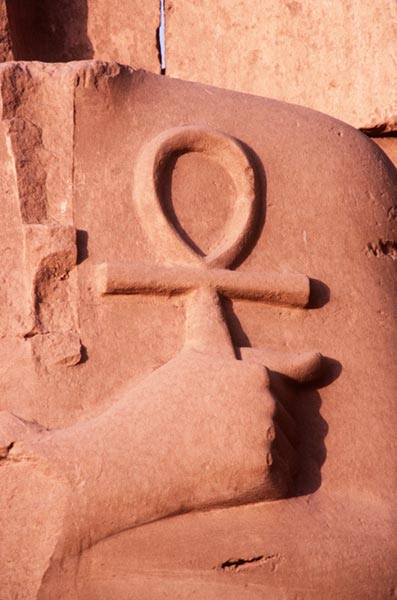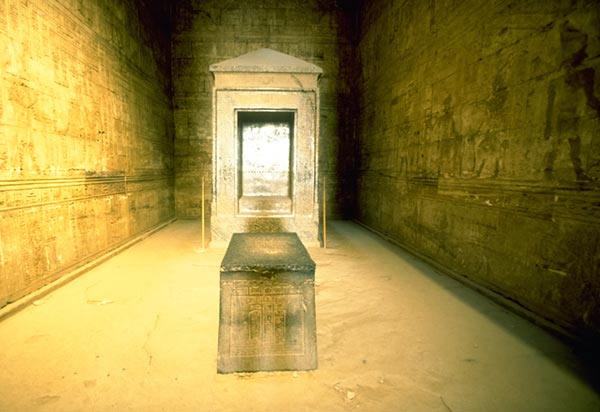
Giza Pyramids, Egypt (Enlarge)
Egyptian civilization in its characteristic form suddenly and mysteriously emerged from prehistory around 3100 BC. Although the nature of Egyptian society underwent a process of slow change over the centuries, many of its outward features survived into a period, 3000 years later, when the country was ruled by Greek-speaking Ptolemies, and after them by the Roman emperors. Most of our knowledge of ancient Egypt concerns the history and culture of the Egyptian court that centered on a hereditary 'divine' kingship at the head of a powerful administrative apparatus. Egyptologists have grouped the families of kings, or Pharaohs, into thirty-one dynasties leading to the time of the conquest of Egypt by Alexander the Great in 332 BC. Ordered rule under the pharaohs was however, twice interrupted. The Old Kingdom (dynasties 3-6) collapsed through what appears to be a social revolution in about 2280 BC. After a little more than two centuries, order was restored during the Middle Kingdom (Dynasties 11 & 12). The second collapse, beginning late in the 18th century BC, was largely due to the incursions of the Asiatic Hyksos, who for a time ruled much of Egypt. The New Kingdom was established by about 1575 BC and flourished for about 500 years (dynasties 18-20).
A comprehensive and accurate picture of the development of Egyptian civilization is not however, as clear as the preceding chronological listing implies. To put it quite bluntly, while the hieroglyphic language of the Egyptians was deciphered by Champollion in 1822 and succeeding generations of archaeologists have done admirable work in excavating, preserving and measuring the monumental architecture of the Egyptians, current Egyptological 'science' knows next to nothing about the origins of Egyptian civilization and the fundamental philosophy that underlaid it. This matter is far to complex to deal with in this essay but a few quotes from Egyptian specialists will alert my readers to the very limited knowledge we have concerning the ancient Egyptian culture and, most particularly, its origins.
From the brilliant and self-described 'rogue' Egyptologist John Anthony West, we learn that: "It is not until the very last stages of Egypt, in Macedonian and Ptolemaic times (beginning in 332 BC), that anything resembling our form of history exists. Egyptian history, such as it is, has been deduced from inscriptions that are becoming acknowledged as ritual rather than fact. For some particular reason, both scholars and populizers resist telling the unspecialized reader the actual tentative state of affairs, while in the literature intended for the specialist, there is scarcely a sentence that is not hedged about with conditionals and qualified by thickets of footnotes." Furthermore West tell us that: "The sciences, artistic and architectural techniques and the hieroglyphic system show virtually no signs of a period of 'development'; indeed many of the achievements of the earliest dynasties were never surpassed, or even equaled later on. This astonishing fact is readily admitted by orthodox Egyptologists, but the magnitude of the mystery it poses is skillfully understated, while its many implications go unmentioned........Every scholar who has ever studied Egypt has had to acknowledge that the corpus of knowledge was miraculously complete at the beginning: like Athena springing full-blown from the head of Zeus. The predynastic remains show no remains of writing, yet when the hieroglyphs appeared, they did so in complete form and coherency. As scholars have pressed their studies into various aspects of Egypt, in each case the thread goes back to the earliest periods recorded and is then abruptly lost."

Carving of an Ankh, Egyptian symbol of life (Enlarge)
Other scholars echo these statements. The noted Egyptologist Ernst Renan wrote: "Egypt at the beginning appears old, mature, as if the country had never known youth. Its civilization has no infancy, and its art, no archaic period. The civilization of the Old Kingdom did not begin in infancy - it was already mature." In similar tones the historian P.J. Wiseman notes: "No more surprising fact has been discovered by recent excavation than the suddenness with which the Egyptian civilization appeared. Instead of the infinitely slow development anticipated, it has become obvious that Egyptian art and science suddenly burst upon the world." Summing the matter up quite succinctly, an article in the January 1995 issue of the National Geographic magazine stated that: "Scholars puzzle over the cryptic records and the basic questions about the Old Kingdom have remained unanswered." As archaeological excavation probes ever more extensively into the sandy borders of the river Nile, the evidence continues to reveal absolutely no transition whatsoever between the Egyptian civilization of the Old, Middle and New Kingdoms with the Paleolithic and Neolithic cultures that previously inhabited the area.
Given this admittance by the archaeological community of its ignorance of the most fundamental aspects of ancient Egyptian civilization, the present author feels it is important to draw attention to two matters that directly bear upon the subject: namely the rather arrogant refusal by both the past and current Egyptological community to consider the ancient myths concerning the genesis of Egyptian civilization, and deeply interrelated with this, the equally arrogant tendency of most Egyptologists to make assumptions and 'factual' statements concerning the origin and use of certain architectural structures on the Giza plateau. (Again, because these matters are too complex to be dealt with in detail here they will only be mentioned briefly; readers interested in a fuller discussion should consult the excellent works by John Anthony West, Peter Tompkins, William Fix, Graham Hancock, Robert Bauval and Andrew Collins, each of which is listed in the bibliographies on www.sacredsites.com)
Merely because myths are not quantifiable and immediately verifiable as are certain scientific endeavors does not mean their content should be dismissed as lacking in authenticity or relevance. Rather than relegating myth, as so many contemporary scientists do, to the realm of superstition and children's fairy tales, its detractors should broaden their narrow-minded, myopic view points, exercise their intelligence, and seek to decipher the myths as they have so excellently deciphered the ancient hieroglyphs. One myth that most certainly should be given much more scholarly attention is that given in the Timaeus dialogues of Plato (428 - 348/7 BC). Herein Plato mentions that the Egyptian priests told Solon how a mysterious people from a place called Atlantis had invaded much of the Mediterranean area, including Egypt, "some nine thousand years". Edgar Cayce, the American clairvoyant indicated that the Great Pyramid was, at least in its design stage, begun around 10,400 BC. These two references to the enormous antiquity of the pyramid are interesting to consider in relation to the astronomical matter of the precessional motion of the constellation of Orion. Edgar Cayce was not aware of the complex mathematics of precessional change nor that astronomers using computers have now established that in 10,450 BC Orion's pattern in the night sky precisely mirrored the position of the Giza pyramids on the ground.
The present author, by referring to this matter, is not stating that he believes (or disbelieves) that the oldest structures in Egypt - the Sphinx and its temples, the pyramids on the Giza plateau, and the Oseirion at Abydos - are the remnants of an ancient Antlantean civilization. Rather he is drawing much needed attention to the gross lack of understanding resulting from the method of inquiry currently practiced by the community of Egyptological and archaeological scientists. It is impossible for a civilization of such extraordinary mathematical, philosophical, architectural and artistic capacities (to name but a few of its achievements) to have arisen so suddenly from the extremely crude societies of Neolithic Egypt. Something else must account for the grand flowering of Egyptian dynastic culture, and this something else cannot have been simply the influences occasionally brought by wandering traders or attributed to a cluster of tribes peripheral to the Egyptian regions. No, the something else we are speaking of was of a magnitude and degree of development that at least equaled what we can now see of Old Kingdom Egyptian civilization. We know this because there is, as previously mentioned, no evidence of any stages of development in early Egyptian civilization but rather the inescapable fact of its sudden and fully developed emergence. Egypt thus seems to be the inheritor of the knowledge and achievements of a previous - and now mysteriously hidden - civilization that itself must have been the culmination of a multi-century or even millennial period of development. Egypt is the visible, albeit little understood, legacy of an invisible ancestral culture. Today's Egyptologists are extremely uncomfortable with this notion because it upsets their cherished assumptions regarding the origins and development of ancient civilization. To admit to the possibility of a highly developed civilization long preceding the Egyptian and Mesopotamian cultures means that the entire chronological foundation of current archaeological thinking must be entirely rewritten.
The second matter that I wish to draw reader’s attention to concerns the assumptions, currently promulgated as facts by the 'scholars' of Egyptology, regarding the origins, methods of construction, and use of certain monumental structures in the Egyptian deserts. Again, I cannot deal with these matters in lengthy detail here (see West, Tompkins, and Hancock) but will state, quite strongly, that there are no hieroglyphs, no paintings, in fact not one single shred of evidence that proves the Sphinx or the Great Pyramid of the Giza plateau were actually built by the Egyptians of the Old, Middle, or New Kingdoms. John Anthony West comments on this matter, saying: "This is one of the great peculiarities of ancient Egypt. Modern scholars know in considerable detail about Egyptian agriculture and manufacturing techniques - everything from sandal making to goldsmithing. The tomb paintings and friezes are detailed and explicit in these areas. Yet in the civilization that, more than any other, devoted its time, energy, and artistry to building, almost nothing explicit is drawn or written on the subject of building techniques. And what little there is, is unrevealing or ceremonial. Law courts are often shown in progress, but there is no instance of an architect at work. It is difficult to see this silence, extending over three thousand years of Egyptian civilization, as anything but deliberate, but the reason for it must remain conjecture."
There are essentially two types of monumental structures remaining in Egypt today: the pyramid type (some funerary, others not) and the temple type. Regarding the pyramid form, the prevailing archaeological assumptions are that the Egyptians first practiced building enormous funerary structures with the pyramids of Saqqara and Dashur and then, once they had their construction techniques perfected, built the amazing pyramids of the Giza plateau, and additionally the Sphinx. A growing body of other researchers however, believes this chronology to be backwards. The alternative interpretation is that the Egyptian people of Dynastic times found the fantastic structures in the deserts and attempted to copy them and utilize the copies for funerary reasons. I will deal with this matter in more detail in the essay on the Great Pyramid, also featured on www.sacredsites.com.
Regarding the non-pyramid form of monumental architecture here again we find two basic types: the tombs and temples of the Kings and Queens such as are found at Abu Simbel and the West Bank at Luxor, and the sacred temples of the Egyptian deities found at Edfu, Dendera, Abydos, and Kom Ombo. While the temples and tombs of the Kings and Queens were often the focal points of religious cults following the death of these royal persons, these cults usually lasted no more than a few hundred years as they were soon replaced by new cults dedicated to living or more recently dead royal personages. Thus the funerary structures of the Kings and Queens are not considered to have functioned as sacred places and pilgrimage shrines such as the temple sites at Edfu, Dendera, Abydos, and Kom Ombo. Regarding these vastly more important temples, Robert Lawlor explains that for the ancient Egyptians "The temple was a center of the learning and dissemination of a psycho-physical and spiritual science whose purpose was to reveal and develop symbolic, intellectual and physical techniques which might effect perceptual, behavioral and physiological changes in the human organism - a science having the purpose of gradually leading towards humanity's highest conceivable evolutionary potential, towards the appearance, that is, of a Divine or Supra-Human, an organismic being who has mastered the contingencies and dualities of mortal existence". (For more on this matter see Lawlor's chapter, Ancient Temple Architecture, in Homage to Pythagoras, edited by Bamford, Christorpher)

Inner sanctuary of Temple of Edfu, Egypt (Enlarge)
 Martin Gray is a cultural anthropologist, writer and photographer specializing in the study of pilgrimage traditions and sacred sites around the world. During a 40 year period he has visited more than 2000 pilgrimage places in 165 countries. The World Pilgrimage Guide at sacredsites.com is the most comprehensive source of information on this subject.
Martin Gray is a cultural anthropologist, writer and photographer specializing in the study of pilgrimage traditions and sacred sites around the world. During a 40 year period he has visited more than 2000 pilgrimage places in 165 countries. The World Pilgrimage Guide at sacredsites.com is the most comprehensive source of information on this subject.
